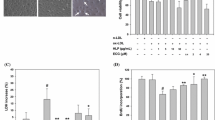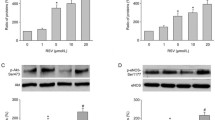Abstract
One of characteristics of diabetes mellitus (DM) is endothelial cell (EC) dysfunction and apoptosis which contributes to the development of vasculopathy. Advanced glycation end products (AGEs) continuously produced in the setting of DM play an important role in causing EC dysfunction and apoptosis. However, the underlying molecular mechanism remains largely elusive. Lactadherin, a secreted glycoprotein of milk-fat globule, is expressed by multiple cell types of arterial wall including ECs. Our previous proteomic studies showed that the expression of lactadherin was significantly increased in the aorta of diabetic rats as compared with control rats and treatment with grape seed procyanidin extracts significantly inhibited the lactadherin expression in diabetic rats. We hypothesized that lactadherin plays a critical role in AGEs-induced EC apoptosis; grape seed procyanidin B2 (GSPB2) and resveratrol protect against AGEs-induced EC apoptosis through lactadherin regulation. Our results showed that AGEs upregulated lactadherin expression and lactadherin RNA interference significantly attenuated AGEs-induced EC apoptosis. Overexpression of lactadherin increased EC apoptosis with up-regulation of Bax/Bcl-2 ratio, cytochrome c release, caspase-9 and caspase-3 activation suggesting the involvement of mitochondria apoptosis pathway. Mechanistically, overexpression of lactadherin reduced the phosphorylation of GSK3beta at baseline. Our study also revealed nine proteins interacting with lactadherin in HUVEC and study of these candidate proteins could unveil further underlying molecular mechanisms. In summary, our study identified lactadherin as a key player responsible for AGEs-induced EC apoptosis and antioxidants GSPB2 and resveratrol protect against AGEs-induced EC apoptosis by inhibiting lactadherin. Targeting lactadherin with antioxidant could be translated into clinical application in the fighting against DM complications.








Similar content being viewed by others
References
Lin EH, Rutter CM, Katon W, Heckbert SR, Ciechanowski P, Oliver MM et al (2010) Depression and advanced complications of diabetes: a prospective cohort study. Diabetes Care 33:264–269
Cull CA, Jensen CC, Retnakaran R, Holman RR (2007) Impact of the metabolic syndrome on macrovascular and microvascular outcomes in type 2 diabetes mellitus: United Kingdom Prospective Diabetes Study 78. Circulation 116:2119–2126
Brownlee M (2001) Biochemistry and molecular cell biology of diabetic complications. Nature 414:813–820
Zhou YJ, Yang HW, Wang XG, Zhang H (2009) Hepatocyte growth factor prevents advanced glycation end products-induced injury and oxidative stress through a PI3K/Akt-dependent pathway in human endothelial cells. Life Sci 85:670–677
Xiang M, Yang M, Zhou C, Liu J, Li W, Qian Z (2006) Crocetin prevents AGEs-induced vascular endothelial cell apoptosis. Pharmacol Res 54:268–274
Coughlan MT, Thorburn DR, Penfold SA, Laskowski A, Harcourt BE, Sourris KC et al (2009) RAGE-induced cytosolic ROS promote mitochondrial superoxide generation in diabetes. J Am Soc Nephrol 20:742–752
Alikhani Z, Alikhani M, Boyd CM, Nagao K, Trackman PC, Graves DT (2005) Advanced glycation end products enhance expression of pro-apoptotic genes and stimulate fibroblast apoptosis through cytoplasmic and mitochondrial pathways. J Biol Chem 280:12087–12095
Andersen MH, Berglund L, Petersen TE, Rasmussen JT (2002) Annexin-V binds to the intracellular part of the beta(5) integrin receptor subunit. Biochem Biophys Res Commun 292:550–557
Silvestre JS, Théry C, Hamard G, Boddaert J, Aguilar B, Delcayre A et al (2005) Lactadherin promotes VEGF-dependent neovascularization. Nat Med 11:499–506
Li XL, Li BY, Gao HQ, Cheng M, Xu L, Li XH et al (2010) Proteomics approach to study the mechanism of action of grape seed proanthocyanidin extracts on arterial remodeling in diabetic rats. Int J Mol Med 25:237–248
Choi SE, Kang Y, Jang HJ, Shin HC, Kim HE, Kim HS et al (2007) Involvement of glycogen synthase kinase-3beta in palmitate-induced human umbilical vein endothelial cell apoptosis. J Vasc Res 44:365–374
Miura T, Chiba M, Kasai K, Nozaka H, Nakamura T, Shoji T et al (2008) Apple procyanidins induce tumor cell apoptosis through mitochondrial pathway activation of caspase-3. Carcinogenesis 29:585–593
Zunino S (2009) Type 2 diabetes and glycemic response to grapes or grape products. J Nutr 139:1794S–1800S
Houde V, Grenier D, Chandad F (2006) Protective effects of grape seed proanthocyanidins against oxidative stress induced by lipopolysaccharides of periodontopathogens. J Periodontol 77:1371–1379
Khanna S, Venojarvi M, Roy S, Sharma N, Trikha P, Bagchi D et al (2002) Dermal wound healing properties of redox-active grape seed proanthocyanidins. Free Radic Biol Med 33:1089–1096
Vayalil PK, Mittal A, Katiyar SK (2004) Proanthocyanidins from grape seeds inhibit expression of matrix metalloproteinases in human prostate carcinoma cells, which is associated with the inhibition of activation of MAPK and NF kappa B. Carcinogenesis 25:987–995
Chen DM, Cai X, Kwik-Uribe CL, Zeng R, Zhu XZ (2006) Inhibitory effects of procyanidin B(2) dimer on lipid-laden macrophage formation. J Cardiovasc Pharmacol 48:54–70
Mackenzie GG, Adamo AM, Decker NP, Oteiza PI (2008) Dimeric procyanidin B2 inhibits constitutively active NF-kappaB in Hodgkin’s lymphoma cells independently of the presence of IkappaB mutations. Biochem Pharmacol 75:1461–1471
Csiszar A, Smith K, Labinskyy N, Orosz Z, Rivera A, Ungvari Z (2006) Resveratrol attenuates TNF-alpha-induced activation of coronary arterial endothelial cells: role of NF-kappaB inhibition. Am J Physiol Heart Circ Physiol 291:H1694–H1699
Zhang FL, Gao HQ, Wu JM, Ma YB, You BA, Li BY et al (2006) Selective inhibition by grape seed proanthocyanidin extracts of cell adhesion molecule expression induced by advanced glycation end products in endothelial cells. J Cardiovasc Pharmacol 48:47–53
Bhatwadekar AD, Ghole VS (2005) Rapid method for the preparation of an AGE-BSA standard calibrator using thermal glycation. J Clin Lab Anal 19:11–15
Zhang Y, He L, Zhou Y (2008) Taspine isolated from Radix et Rhizoma Leonticis inhibits growth of human umbilical vein endothelial cell (HUVEC) by inducing its apoptosis. Phytomedicine 15:112–119
Nakagami H, Morishita R, Yamamoto K, Yoshimura SI, Taniyama Y, Aoki M et al (2001) Phosphorylation of p38 mitogen-activated protein kinase downstream of bax-caspase-3 pathway leads to cell death induced by high d-glucose in human endothelial cells. Diabetes 50:1472–1481
Yamagishi S, Nakamura K, Matsui T (2009) Regulation of advanced glycation end product (AGE)-receptor (RAGE) system by PPAR-gamma agonists and its implication in cardiovascular disease. Pharmacol Res 60:174–178
Hodgkinson CP, Laxton RC, Patel K, Ye S (2008) Advanced glycation end-product of low density lipoprotein activates the toll-like 4 receptor pathway implications for diabetic atherosclerosis. Arterioscler Thromb Vasc Biol 28:2275–2281
Hanayama R, Tanaka M, Miwa K, Nagata S (2004) Expression of developmental endothelial locus-1 in a subset of macrophages for engulfment of apoptotic cells. J Immunol 172:3876–3882
Hanayama R, Tanaka M, Miwa K, Shinohara A, Iwamatsu A, Nagata S (2002) Identification of a factor that links apoptotic cells to phagocytes. Nature 417:182–187
Aoki N, Jin-no S, Nakagawa Y, Asai N, Arakawa E, Tamura N et al (2007) Identification and characterization of microvesicles secreted by 3T3-L1 adipocytes: redox- and hormone-dependent induction of milk fat globule-epidermal growth factor 8-associated microvesicles. Endocrinology 148:3850–3862
Neutzner M, Lopez T, Feng X, Bergmann-Leitner ES, Leitner WW, Udey MC (2007) MFG-E8/lactadherin promotes tumor growth in an angiogenesis-dependent transgenic mouse model of multistage carcinogenesis. Cancer Res 67:6777–6785
Yang Z, Mo X, Gong Q, Pan Q, Yang X, Cai W et al (2008) Critical effect of VEGF in the process of endothelial cell apoptosis induced by high glucose. Apoptosis 13:1331–1343
Zhang Z, Lapolla SM, Annis MG, Truscott M, Roberts GJ, Miao Y et al (2004) Bcl-2 homodimerization involves two distinct binding surfaces, a topographic arrangement that provides an effective mechanism for Bcl-2 to capture activated Bax. J Biol Chem 279:43920–43928
Tan C, Dlugosz PJ, Peng J, Zhang Z, Lapolla SM, Plafker SM et al (2006) Auto-activation of the apoptosis protein Bax increases mitochondrial membrane permeability and is inhibited by Bcl-2. J Biol Chem 281:14764–14775
Chen L, Zhang Y, Sun X, Li H, Le Sage G, Javer A et al (2009) Synthetic resveratrol aliphatic acid inhibits TLR2-mediated apoptosis and an involvement of Akt/GSK3beta pathway. Bioorg Med Chem 17:4378–4382
Linseman DA, Butts BD, Precht TA, Phelps RA, Le SS, Laessig TA et al (2004) Glycogen synthase kinase-3beta phosphorylates Bax and promotes its mitochondrial localization during neuronal apoptosis. J Neurosci 24:9993–10002
King TD, Bijur GN, Jope RS (2001) Caspase-3 activation induced by inhibition of mitochondrial complex I is facilitated by glycogen synthase kinase-3beta and attenuated by lithium. Brain Res 919:106–114
King TD, Jope RS (2005) Inhibition of glycogen synthase kinase-3 protects cells from intrinsic but not extrinsic oxidative stress. Neuroreport 16:597–601
Miura T, Miki T (2009) GSK-3beta, a therapeutic target for cardiomyocyte protection. Circ J 73:1184–1192
Chew GT, Watts GF (2004) Coenzyme Q10 and diabetic endotheliopathy: oxidative stress and the ‘recoupling hypothesis’. QJM 97:537–548
Choi YJ, Lim SS, Jung JY, Choi JS, Kim JK, Han SJ et al (2008) Blockade of nitroxidative stress by roasted licorice extracts in high glucose-exposed endothelial cells. J Cardiovasc Pharmacol 52:344–354
Chao CL, Hou YC, Chao PD, Weng CS, Ho FM (2009) The antioxidant effects of quercetin metabolites on the prevention of high glucose-induced apoptosis of human umbilical vein endothelial cells. Br J Nutr 101:1165–1170
Ma L, Gao HQ, Li BY, Ma YB, You BA, Zhang FL (2007) Grape seed proanthocyanidin extracts inhibit vascular cell adhesion molecule expression induced by advanced glycation end products through activation of peroxisome proliferators-activated receptor gamma. J Cardiovasc Pharmacol 49:293–298
Zhang FL, Gao HQ, Shen L (2007) Inhibitory effect of GSPE on RAGE expression induced by advanced glycation end products in endothelial cells. J Cardiovasc Pharmacol 50:434–440
Pabona JM, Velarde MC, Zeng Z, Simmen FA, Simmen RC (2009) Nuclear receptor co-regulator Krüppel-like factor 9 and prohibitin 2 expression in estrogen-induced epithelial cell proliferation in the mouse uterus. J Endocrinol 200:63–73
Steglich G, Neupert W, Langer T (1999) Prohibitins regulate membrane protein degradation by the m-AAA protease in mitochondria. Mol Cell Biol 19:3435–3442
Osman C, Merkwirth C, Langer T (2009) Prohibitins and the functional compartmentalization of mitochondrial membranes. J Cell Sci 122:3823–3830
Ross JA, Nagy ZS, Kirken RA (2008) The PHB1/2 phosphocomplex is required for mitochondrial homeostasis and survival of human T cells. J Biol Chem 283:4699–4713
Kasashima K, Ohta E, Kagawa Y, Endo H (2006) Mitochondrial functions and estrogen receptor-dependent nuclear translocation of pleiotropic human prohibitin 2. J Biol Chem 281:36401–36410
Acknowledgments
This work was supported by National Natural Science Foundation of China (30873145, 81000340), Outstanding Young Scientist Research Award Fund of Shandong Province (BS2009YY046), China Postdoctoral Science Foundation (20100471520) and Natural Science Foundation of Shandong Province (Y2008C100, ZR2010HQ067). We wish to thank the personnel in Medical Science Academy of Shandong and the personnel in Research Center for Proteome Analysis, Shanghai Institute for Biological Sciences, Chinese Academy of Sciences. We also thank Professor Ji-yuan Ding for his assistance.
Conflict of interest
The authors declare that they have no conflict of interest.
Author information
Authors and Affiliations
Corresponding author
Additional information
Bao-ying Li, Xiao-li Li and Qian Cai contributed equally to this work.
Rights and permissions
About this article
Cite this article
Li, By., Li, Xl., Cai, Q. et al. Induction of lactadherin mediates the apoptosis of endothelial cells in response to advanced glycation end products and protective effects of grape seed procyanidin B2 and resveratrol. Apoptosis 16, 732–745 (2011). https://doi.org/10.1007/s10495-011-0602-4
Published:
Issue Date:
DOI: https://doi.org/10.1007/s10495-011-0602-4




